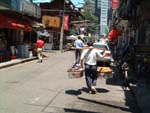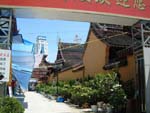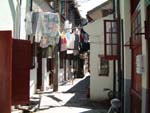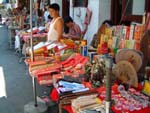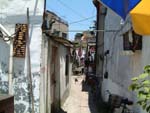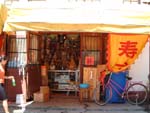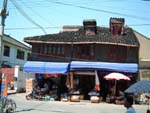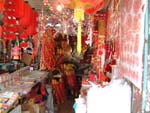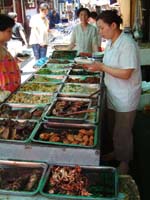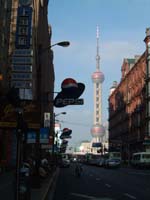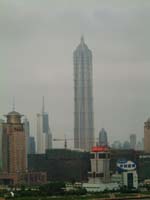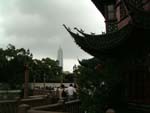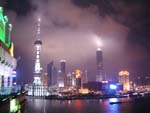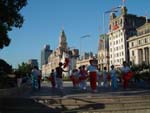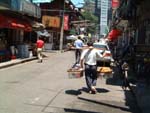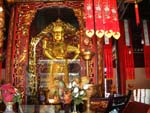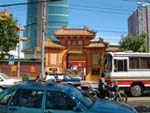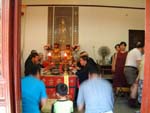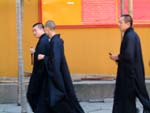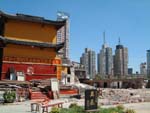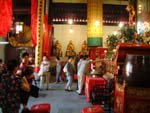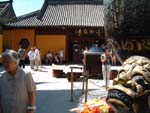Published John Wiley & Sons - 2002
CHAPTER 3 - Shanghai::
Alan Balfour
There was a Shanghai before Shanghai and in when the British arrived it was a tough prosperous port with a volume of shipping equal to that of the Pool of London in the same years.
The Chinese were skilled cartographers and land planners, as evidenced by an exquisite map of China from the 11th century, whose accuracy is recognisable even today. Such experience was essential in administering a vast land and in gaining physical control over it through some of history's most extensive public engineering projects. The Great Wall and the Grand Canal were for centuries in a continuous process of building, rebuilding and relocating, with the guidance of surveyors, hydrologists, civil engineers, logicians - areas of knowledge either non-existent or neglected in the West.
The upper, middle and lower Yangtze regions had been the setting for town and city formation since the Spring and Autumn Era (772-481 BC). Between the 6th and 3rd centuries BC, the capital of the Wu people, Wuden, was established close to what would become the garden city of Suzhou. East of Suzhou, the Yangtze had always been too tidal and the land too marshy to provide a secure harbour or to support permanent settlement. However, during the Sui Dynasty (7th century AD) many small ports developed along the tributaries and canals flowing into the Yangtze. It was at this time that the village of the Hu or Hudu appears on the records at the confluence of the Huangpu and the Wusong (later Suzhou Creek). Three centuries later, during the Tang Dynasty, this would emerge as the river port of Shanghai. 'Shanghai' is composed of two Chinese characters: 'Shang', meaning 'on', and 'hai' meaning 'sea'.
Song Shanghai
Song Shanghai gained strength after river silting closed the market centre of Quinlong to its west, and although it developed in a marshy, undeveloped area at the edge of a region dominated by the great cities of Hangzhou and Suzhou, the earliest records show that it was emerging as a port of some significance. It received its official designation as a market town - zhen - in 1074. An office of diverse trades was established in 1119, and it was named market city - shi - in 1159. Most of the temples and schools that gave character to the early city were formed and founded under the Southern Song Dynasty in the glorious period between 1127 and 1279 when the Empire was holding out against the might of the Moguls. Its capital Hangzhou was a brilliant centre of culture, as evidenced later by Marco Polo, and not more than three days travel from Shanghai. In the administrative reorganisation during this period, the Song divided up the former kingdom of Wu Yae to create the Jinxing prefecture, increasing the significance of the Huangpu River and consequently of Shanghai. The early population records for the county show less than 12,000 households, but this would soar to a quarter of a million in 1127, absorbing the exodus from Kaifeng during the Mongol invasion that destroyed the Northern Song. Yet, as elsewhere in China, even after the city was brought within Mogul rule under the Yuan Dynasty in 1279, it grew in modest confidence and prosperity, never suffering the abandonment or devastation of the imperial capitals.
Yuan Shanghai (1279-1368)
The earliest mapping of Shanghai took place during the Yuan Dynasty (1279-1368) in the 13th century. As with all such early maps, it restricts itself to the general positioning of the many waterways within the region. A simplified diagram, this official record is a factual display of the complex of arteries that sustain this small city, linking it to the Huangpu River, then to the Yangtze, and then across all of China via the Grand Canal. The abstract mapping is reminiscent of the London Tube map: it represents essential relationships and shows no concern for specific geographical or topological features. Most of those who made their living on the waterways would have been illiterate, and this is a diagram by and for the local administration. The Huangpu River flows upwards to the right edge, with the Suzhou Creek running across the top. Only the major canals are named. Emphasis is given to the names of the bridges over the canal, which are shown in lozenge-shaped frames. Throughout the town centre, between the main canals, several character blocks in frames show the location and title of the various offices of the imperial administration. The short stretch of canal at the very centre of the town runs alongside the central food market. Despite its simplicity, the map also attempts to present the changing order of the city and the shifting locations of major functions - food, temples, administration - recording not only their present location but where they stood in previous dynasties. This unadorned document provides us with a simple description of the commercial waterways with Shanghai at the centre.
From this earliest plan there is a suggestion that the old city of Shanghai was based on the grid-like network of canals flowing from the Huangpu River. But as the city grew, changed and intensified, the grids were softened and the canals filled in by the dense buildings growing in every available space.
Yuan Shanghai became the county seat of the Songjiang region in 1292, with a population of 64,000 households. Given the relatively large size of an average family, this was a considerable number. The Yuan town continued to form around the three major canals flowing east into the Huangpu, which had been opened during the Song era. This town between the waterways was a mass of houses, workshops, stores, linked across the canals by 27 bridges and 'packed together like the scales of a fish' according to one contemporary record. The Yuan were tolerant of all religion, and the major temples were restored and extended. Extensive land reclamation projects developed south of the town, with the damming and poldering of marshland funded by taxes and special grants. The Yuan administration established a new school, which, following Song practice, was endowed with the proceeds from extensive agricultural holdings. Underscoring the commercial significance of the town they established Yuan Xi'an Prefecture College to train the county administrators, the Yuan Military Circuit Office, the Yuan office for grain transport, the Yuan Wine Distribution Warehouse and the Office of Overseas Trade; a second office for overseas trade and taxation was soon established.
The Yuan oversaw improvements in agricultural tools and water control, and the introduction of a new strain of early ripening rice greatly increased yields. But it was the development of a new cash crop, cotton that transformed the economy of the entire delta. The cotton revolution propelled the Songjang region and Shanghai from a marshy periphery, at best a land of rice and fish, into national prominence as one of the most prosperous and progressive districts of the Empire. The cotton bush and its cultivation came to China from India in the 13th century and quickly became central in the brackish lands to the west of Shanghai. Cotton not only became the cornerstone of Shanghai's market economy, but also improved the dress of the masses. Until cotton arrived, silk was a fabric exclusive to the court and the wealthy, while the poor who produced it had to make do with rough cloth of hemp or ramie. Production was continually improved by innovations in technology. The Chinese cotton gin, mechanically similar to Eli Whitney's invention of some 400 years later, was in use by the 13th century, and equally inventive devices were developed for pummelling and fluffing the ginned material. Two crops dependent on water - rice relying on flooded fields, and cotton on waterways for its transport - forced the development around Shanghai of elaborate and precise water management, but it was cotton that transformed and strengthened the structure of the region's economy. Linda Cooke Johnson quotes from the contemporary Chinese historian Zhang Zhongmin's 1987 book on the city: 'the lands in front of the Huangpu were planted with cotton from the river to sea. The land was white like the sky with the cotton flowers; men planted, women spun and wove.'
The city under the Ming (1368-1644)
A Ming map of 1533 maintains the pragmatism of the earliest records of Shanghai, showing the network of waterways and villages across the country. It is a practical document in which the Huangpu River forms a diagonal across the sheet, joined recognisably by the Suzhou Creek east of centre. Just below the junction the boxed text establishes the location of the imperial administration.
Unlike the map makers of Europe, who felt the need to embellish their descriptions of cities with the evocation of Divine forces and exaggerated effects, the Chinese map maker was a strict recorder of facts. This, again, is a document for administrators by administrators. It makes no attempt to represent any other aspect of the town. There is no indication of the many paths that must have linked the sequence of bridges, nor of the homes and workshops that would have been crowded onto the land between the canals. No attempt is made to re-present the actual physical qualities of the city. This is not a document about what might be, but wholly about what is. The map had only one function - to register those elements of the city that were the specific concern of the town administrators and tax collectors: the volume of shipping and the movement of goods on the canals. All elements presented can be considered as aspects of public works. So on the one hand this map is a pragmatic diagram of the key transportation networks within the town, and, on the other, it documents the imperial sphere of influence. Underlying the gently wandering paths of the three lateral canals is an indication that when first laid out, these were formed in a regular set of parallel channels intersected by a partial grid of transverse connections. So flat is the delta, and so wayward the path of the rivers and streams, that this 16th-century description accurately reflects the result of several centuries' struggle between the man-made order and nature.
During the Ming period, Shanghai differed only in scale and population from the many small market towns throughout the region - towns whose planning and structure were the product of reason and circumstance rather than imperial ideal. On coming to power, the greatest of Ming emperor, Yongle (1360-1420), moved the capital from Nanjing to Beijing and immediately began the restoration of the Grand Canal. The canal linking Beijing with the Yangtze was reopened in 1415, becoming once again the major artery of the nation and carrying the great part of the emperor's annual grain tax. Of the total tax, 10 per cent came from Suzhou and Shanghai alone, giving some indication of the productivity of the region and the volume of shipping passing through it. To effect this transportation and to strengthen the river connection between Shanghai and the Yangtze, the decision was made to dredge the Wusong and the Huangpu. Though linked to imperial strategy the decision was taken locally and work was funded by commercial tariffs and local agricultural taxes. Shanghai had developed just south of the confluence of the Wusong and Huangpu, and east to the Yangtze estuary, which made them subject to the build-up of both silt and sand as the river mixed with the tidal sea currents. Ming officials resolved the problem by dredging a channel to allow both rivers to flow north to the Yangtze. This combined force reduced the effect of the tidal currents and greatly lessened the problems of silting. Just as significantly, it allowed shipping entering the estuary of the Yangtze the choice of sailing in many directions, where previously all shipping into the China Sea had been forced by winds and currents to sail south. The new channel would link Shanghai permanently to the Yangtze and to all the important internal and external shipping routes.
The Wall
The most significant construction in the city between its emergence as a market town in the 12th century and the arrival of the British in the 19th century was the building in 1554 of the city wall.10 The commercial strength of Shanghai during the 15th and 16th centuries attracted continual and destructive raids from the sea by pirates - the Wukou (Wu - 'short' or 'ugly', and Kou - 'invader', referring presumably to the Japanese). These eventually threatened the very survival of the city. During the reign of Yongle (1403-24), there had been extensive international trade with Japan, the states of the Southern Seas, Indonesia and the Philippines. In the succession of short-lived empires that followed the death of Yongle, however, a far-reaching and destructive imperial decree prohibited all maritime trade, and made outlaws of all those attempting to maintain commercial links with the islands to the east. It also led to the withdrawal of imperial naval defence, leaving the coastal cities open to attack. The source of the piracy is presumed to have been Chinese sailors in co-operation with the Japanese. Politically, Japan was experiencing a period of extreme instability with no effective authority controlling either land or sea.
The problem assumed crisis proportions during the reign of Jiajing (1522-67) with continual raids along the coast. The response from the imperial court was to increase the prohibition of sea traffic and close down all port activity. In some areas, people living near the coast abandoned their homes and moved inland to escape the threat of attack. Imperial forces sent to defend the coast were so neglected by the administration that they were forced to steal from the very people whom they were meant to protect. In 1553, despite the presence of the Ming army, a pirate force of several thousands sacked Shanghai. The population fled, leaving the town to be plundered, the barges on the canals and river burned or sunk.
On reoccupying the town the citizens appealed to the city administration: In earlier times though the city has not had a wall marauders have not dared to come in because the population, on the whole, was of valiant, sturdy sailors, able to protect themselves and their families against all threats . . . now the population of the county has increased many times over, now there are many rich men in the city who have cash and property . . . wealth from commerce has accumulated. Less than one li outside the city is the Huangpu river offering access to evildoers. In the reign of the present emperor [1522-67] alone, no fewer than 100 gentry and merchant families have lost their lives, money and property. [Now] all the population (the old hundred names) of the county have come together to request official permission to build a city wall.
The wall was begun in 1554. It was not designed to enclose the entire town but was formed as an oval ring around the old heart of the city, some distance back from the river, cutting through the dense buildings of the city and diverting the canals to form a moat. Strictly rectangular enclosures were reserved for imperial orders. The effect was to create two cities: the old administrative one within the wall and an extensive residential, ship-building and warehousing area outside the wall to the south and east. The canny Chinese engineers kept all dimensions to an effective minimum: the wall had a circumference of 3 1/2 miles and was 12 feet in height, while the moat was 7 feet deep; there were six land and three water gates. The wall helped, but the piracy was finally brought to an end by more effective imperial intervention and by the emergence of a unified and stable Japan. The city quickly returned to business as the threat of attack diminished. By the end of the 16th century, international trade resumed, as illustrated by the arrival of four galleons from Manila taking on board silks and porcelain bound for the Mexican port of Acapulco. The lasting effect of the wall was to form a subtle psychological barrier between the discipline of the official city and the polyglot profusion of the industrial port.
The public policy of the Ming administration was encapsulated in the phrase Tian Xia Wei Gong ('All under heaven is for the benefit of the people'). The plan of the Ming city shows the degree to which the emperor's officials controlled its affairs. At the centre was the Yamen, the buildings of the county magistrate and the official (Xi'an) school. It is recorded that the compound of the imperial administration was viewed by the population as a place of harsh authority and was entered only under duress or necessity. To the northeast were the city temple and the Yu Yuan Gardens. Waterways were the major transportation routes and, in many senses, the major focus of public life. The city streets, many marked by commemorative arches, were narrow, lined with workshops and stalls, markets and a great number of wine shops. The majority in the town lived above their businesses in small rooms, but many of the houses had little courtyards where friends would meet.
Large formal gardens were laid out for the pleasure of elite officials and merchants to stimulate the intellect and the senses. Shanghai's most significant garden, the Yu Yuan 'garden of preparedness' or 'pleasure garden', was established in 1559 by Pan Yunduan as a tribute to his father's leadership in building the city wall. (It is the only surviving Ming garden in the city and now virtually the only place in the city that provides an enveloping sense of the past.) It was designed by Zhang Nanyung, a landscape artist from Suzhou, and during the Qing Dynasty it was incorporated into the grounds of the city temple. Other gardens, the Spring Dew Garden and the Crane Crossing Pavilion, later called the Pearl Bud Garden, are memorable only for their seductive names.
One of the great sights of the town, then as now, was the Longhua Buddhist temple far to the southwest. It has a history far more ancient than the town itself, dating back before the second century. The end of the 16th century, the most active period of temple building in the Ming Dynasty, saw 100 new temples built and four restored. Shanghai has had temples dedicated to the Dragon King, the Three Dragons King, the Yellow Emperor, the Three Officials, and Buddhist Bodhisattvas have become part of the celebration of popular heroes and spirits. However, the city temple was and remains the most important. City temples traditionally house the City God, a real person, who in life offered exemplary service to the city. Shanghai chose, shortly after his death, the Yuan scholar and bureaucrat Oum Yubo (born in 1295), who was deemed uniquely virtuous because he had continuously refused the invitation to join the imperial court. The temple was rebuilt and rededicated in 1602 and still stands beside the Yu Yuan Gardens, most recently rebuilt and re-dedicated in the mid 1990s. Chinese gods are much more friendly and accessible than their counterparts in the West. Temple rituals and symbols have none of the cold mystery and uneasiness of Christian rites. The performances around the city temple remain at the public heart of Shanghai.
Set among the winding lanes that lace through the dense fabric of the town, the temple precinct was the most significant place of gathering, ritual and performance. Meetings with family and friends, sermons, sacred festivals, theatrical and operatic performances both secular and sacred, all took place within the temple precinct. The ritual surrounding ceremonies, processions, sacred days, festivals and popular events determined the sequence of daily life and marked the intervals of the year. This is not so dissimilar to the towns of Renaissance Italy, where parishes defined neighbourhoods and the grand spaces in front of the cathedral were as much secular as sacred. But the mythic gods at the heart of these two communities could not have been more different. In Europe was a people spiritually under the control of an omniscient and dreadful God who demanded the suppression of life in the present in preparation for the afterlife. In China many small gods offered spiritual guidance, and even lesser deities, who existed exclusively to offer comfort, gave advice, eased the chores of daily life and celebrated the pleasures of the seasons. In entering the numerous temples to the three alternative spiritual paths - the City Gods, Buddha and the Dao - one never experiences a feeling of intrusion, of being unwelcome. Nature and the world are self-created in Chinese thought: the forms in life and nature are immanent, not imposed externally by divine decree. And the delicate metaphysics of the temples is far more rational and appropriate to this belief than the tragic scenes central to the imagery of Christianity. China's tragedies are man-made.
In two maps from the 17th and 19th centuries, the old city sits within the distorted circle of the wall, an order that frames it to this day. These are maps from the official records of the city, the only context in which the city would be so described. Judging from the use of signs and symbols, both appear to have evolved out of the earlier maps of the city, which is consistent with the continuity within the Chinese Civil Service, but each adds some surprising new visual effects. The basic pattern of the early city - transverse canals flowing into the Huangpu River - continues to dominate the order. The canals trace a slightly more wayward course than a century earlier, however, and several channels have been closed, and new ones opened. The bridges are again named in lozenge-shaped boxes over the canals, and significant buildings are named in framed boxes. Now, in addition to the text, they are illustrated by small pictorial representations - the buildings are symbolised by a wall and a roof, some larger than others, suggesting relative importance. The first map begins to record the organisation of the city, dotted lines showing the main paths through neighbourhoods, suggesting a dense and complex fabric. The later map depicts many more lanes, some dotted more heavily than others, suggesting major and minor routes. The later map also gives slightly more detail to the building symbols, adding roof tiles and a window and door. It is significant that, although they have very different functions, temples, administration buildings and schools are each represented by the same symbol, while the fortifications dominate these new maps, forming an imperfect circle, or squashed oval, around the city. (It is interesting to compare the informal order of these walls with the geometrically perfect 16th-century defences of many cities in southern Europe.) A moat encircling the city outside the walls is linked to the canals. The three major canals pass through arches in the walls as they flow east to the Huangpu. In both maps, the walls are given architectural detail and shown in simple three-dimensional projection as seen from the air. There is more elaboration and accuracy in the later drawing, but both pay a great deal of attention to the representation of the thickness and texture of the wall, its crenellations and the architecture of the gatehouses sitting above the arched entries. There are single gates into the walled city on the north, south and west, and several on the east side, the wall arching over the main canals that flow into the old city.
This shift from the purely diagrammatic to a system of symbolic representation suggests changes both in the way the map was viewed and in its intended audience; the map was no longer merely an instrument of bureaucratic control, but a representation of place. These are still official documents, representing official property or issues of concern to officialdom. Yet this is not a major city; it is not marked in any way by the grandeur of the imperial order. It is a circumstantial place, dominated by commerce. The flow of the canals and the pressure of landowners compromise any attempt to establish a regular order in the streets, canals and walls. It suggests that Shanghai, both its structure and its people, has always been an informal, imperfect place, a place ordered by circumstances and reason, free from unnecessary regulation.
To the people of this town, change was slow, almost imperceptible, only the seasons made a difference. Imperial order was controlled and supported by an unyielding nationwide system of laws and taxes. These were administered by a strictly disciplined Civil Service dedicated to serving the emperor and maintaining Confucian harmony and balance in the order of all things. The only Confucian element evident in these plans of Shanghai is the location of the various offices of the imperial administration at the centre of the city. The many temples that offer comfort via the three religious paths are placed in neighbourhoods around the city at some distance from the centre.
The wall is presented in this way not as a picturesque flourish, but as a document of the technologies of defence and warfare, whose forms, even in the drawings, would have been fully understood in Europe. The crenellations protected the archers, and the semi-circular extensions of masonry that flank all the major gates may reflect Chinese superiority in firearms, the wall, high and curved to deflect the impact of cannon fire. The wall acts to cut the city off from the river. In the later map, the stretch of land along the river's edge is crisscrossed with paths, suggesting the emergence of new activities and industries able to develop more freely outside the constraints of the city.
This community of small, helpful gods was the antithesis of the Divinely distorted cities of Europe in the 16th century. The paths through the neighbourhoods offer the only evidence of the life of the townspeople. These are somewhat informal and meander circuitously through the islands formed by the canals. The paths on the east of the city are much more direct than those on the west and seem more concerned with defining property boundaries than with efficient movement through the town. We can assume from the evidence that these were people with the freedom of self-determination, able to use their wealth to rise within the community, to develop property. More than 60 arches each carry a plaque stating the name of the place and noting its distinction from various districts of the city. There are no signs of imperial luxury here, no marks of an idealised order. The city temple is only presented as a sign, not rendered symbolic, and no attempt is made to suggest the presence of the Yu Yuan Gardens - the public heart of the city.
One can think of the city as a natural system, a crude physical organism. And like natural systems, its essential moving parts are dedicated to the transportation and exchange of materials. The city dwellers are its life's blood. The parts of the system are given attractive exteriors - its architecture - which help explain their function and smooth their operation and experience. This is a place without any illusion - no false promises or exaggerated differences. It is much less interesting, less distinguished than the major cities in the region. The cities visited by Marco Polo were formed, above all, to entertain the imperial tastes and desires of Kaifeng, Nanjing and Suzhou. However, the very ordinariness of Shanghai marks its subsequent evolution and its particular interest in terms of this examination. This was never a city distorted by illusions, yet in its difference from more favoured places it can be said to have become a city of suppressed desire, whose ordinariness would later make it able to absorb European confidence and order.
Even today, in the small trading towns on the rivers to the west such as Tongli and Zhou Zhuang, it is possible to experience the quality of life in late Ming Shanghai. It seems only a short distance from the fields to the edge of the canal. The paths lead straight onto the bridge, so one is unaware of the grandeur of the span until one looks back: a spectacular and effortless leap of stone leads onto a narrow curving street running toward the heart of the town. This passes between two- and three-storey buildings, stores, shop houses and the occasional merchant house, marked by circular moon gates in the walls that screen elegant courtyards. The street ends in the Temple Square, a generous, regular space with a pair of symmetric braziers at its centre, burning incense in front of two slightly neglected bronze lions flanking the path to the temple portal. Inside is a gloomy, sweet-smelling space. On a recent trip I was met by a small man in modest religious dress: a dark grey, long-sleeved gown, belted and reaching to the ground. His bright eyes and wispy beard made him seem like some character from central casting, but he was real. He smiled gently and handed me a well-worn board with a type-written sheet pasted to it. 'This will help you', he said in English. 'You will find we have most kinds of gods here; some may seem familiar.'
Nearby, in the neatly restored City Temple in Zhu Jia Jiao, a carving on a very large abacus - at least 8 feet in length - hung over the entrance gateway. 'Life is a continual calculation', said the woman at the gate as she busied herself preparing lunch for the gatekeeper, 'and one should continually keep an account of good fortune.' The inner temple court was a space of elegant order and tranquillity, perfectly formed to support all the performances, sacred and secular, demanded by the community. The sacred shrine faced a simple, high, covered terrace, essentially a stage for all forms of public performance. Such stages were always built high up, I was told, because performance must always be seen as detached from the ordinary.
In the 17th century, into the last years of the Ming Dynasty, the high official and devout Christian Xu Guong built, in the characteristic Jesuit style, a Catholic mission just outside the north gate to the old city. He had been converted by Jesuit missionaries in southern China in his youth and was renamed Paul; he is still known in the West as Paul Xu. It was he who, working with the Italian missionary Matteo Ricci, translated mathematical texts and wrote scientific treatises based on an oral translation of European works. It was also he who persuaded the Ming court to buy a European cannon in the fight against the Wukou pirates. The site of the mission of Paul Xu was confiscated during the anti-Christian repression in the Kangxi period (1662-1723). (Though this was Catholic not French property, when the French arrived in Shanghai in 1845, they claimed it, and the city authorities returned the land to them.)
(Some sense of the fabric of religious life in the late Ming period can still be found in the more conservative parts of Japan. Japan's religious traditions and rituals were influenced by, and parallel, those of China. Buddhism and Shintoism were both equally egalitarian, and there are shops in the most conservative towns in Japan that sell a wide range of household altars and shrines. The Shinto shrines have an elemental simplicity; they offer solace with nothing more than the simple wooden figure of steps leading to the door of the house. The Buddhist shrines are made in a wide range of sizes, the largest being close to the scale of a wardrobe. Beyond the doors of the cabinet are layers of gilded arches surrounding the Buddha. Though suppressed during the socialist years, such household gods are omnipresent in Hong Kong and Macao, the Shanghainese claim, however, that in Hong Kong the shrines are used only to ask for money).
A poetic evocation of the mood of the city toward the end of the Ming Dynasty can be found in the Kangxi Gazetteer under the title 'View from a High Chamber'. A sensitive eye looks at the city from the upper terrace of one of the administration buildings on a summer's afternoon and sees that the city has all the qualities of a painting:
Mist and clouds wind and coil together with the smoke from cooking fires above the streams and flat lands, swallowing up [the view] and spitting [it] out again; rising and setting like the sun and moon, fleeting and disappearing before our eyes; whether in winter's snows or autumn's gusts [the view of Shanghai] is ever more beautiful.
This description is reinforced by a marvellous drawing from the early Ming period, (also mentioned in the prologue) more immediate even than the Kaifeng scroll, and so fresh that it could be a contemporary scene. This careful, elegant drawing is of the northeast quadrant of the city, the Fang Bang ('square by a small river'). It shows the crowded streets of the town centre in the foreground, the wall rising through a haze in the middle distance, and beyond the port city, spiked with the masts of numerous ships to the far bank of the Huangpu River, the tower of the Customs House in the distance. On the right of the drawing is the great gate of the city wall, through which flows the central canal. Just visible at the centre, barges are being polled between the houses, heading toward the town centre. They pass under the first of the bridges, which is named 'More and more celebration' in the I Ching, and then under the second bridge and the sign for 'long life'. Just left of centre is the great drum, or town clock, housed in a bell tower, whose booming sound set the rhythm and pace of daily life. Close by is the temple to the city god, Guandi.
The drawing shows great charm and variety in its depiction of the homes, businesses and public buildings. Its high vantage point also allows us to peek into the gardens and squares, showing a town with many tree-lined streets and much less congestion than records suggest. We look down on the backs of the houses and across the canals into the speciality stores, the snack shops and even the terrace of a restaurant. The drawing presents a picture of town life that can still be found in the small, highly picturesque water towns to the west of the city between Shanghai and Suzhou, whose main streets are the canals and rivers, and the embankments on either side. High arched bridges dominate the scene, and the many simple structures that together form the town have the rich variety in the detail, yet much of the uniformity of structure, conveyed in the Kaifeng drawing. A small number of materials and building forms is able to encompass all the needs of the community. The drawing conveys an impression of satisfying balance and equity. This is a place without mystery, formed from the familiar, almost universal, patterns produced by community and trade. The simplicity and elegance of the architecture are unified by the limited palette of materials: white-washed walls, wood framing, either oiled or painted Chinese red, and the roof tiles, which are mostly grey but occasionally, on significant buildings, are brightly coloured in reds and greens. The official buildings of the town shown just to the right of centre - and given no special prominence - would have been especially well made. These, and the exceptionally well-engineered stone bridges and embankments were built to last.
The composite effect is of a pragmatic, intelligent society that had formed coherent principles of constructing and organising reality over many centuries. In almost every respect, this drawing shows a Shanghai that differs little in its town life from Kaifeng 500 years earlier, as represented in the scroll. It represents the refinements of an urban life that had at least 2,000 years of previous history. The simple conclusion one draws from such continuity is that this was a culture that had long since become fully realised, and had developed all the necessary instruments to ensure its survival.
The last dynasty, The Qing (1644-1911)
The Qing Dynasty was founded by the Manchu in 1644. In 1643 a Han Chinese, Li Zicheng, led an army of rebellion against the Ming, capturing Xi'an and proclaiming himself emperor. He then marched on the Ming capital of Beijing. The Ming army had positioned itself along the Great Wall as security against Manchurian incursion. As the rebel army approached, the Ming general made the fatal error of inviting the Manchurian forces to help oppose the rebellion. The resulting confusion allowed part of the rebel army to take Beijing. The emperor and empress hanged themselves. In June of 1644 the Manchu army entered Beijing unopposed, and proclaimed the Qing Dynasty with a seven-year-old as its first emperor.
The first three Qing emperors had long reigns, which, when taken together, historians consider to be the greatest period of premodern Chinese history. The Manchus retained the imperial Civil Service and continued to staff it with Confucian-trained Han Chinese literati. Each Chinese province was governed by both a Manchu governor general and a Chinese governor. By imperial decree, marriages were forbidden between the Manchu and the Han Chinese, and men were forced to wear their hair in the Manchu style, gathered into a long pigtail or 'queue'. However, by the 18th century the Manchu had been Sinicised, wholeheartedly embracing Chinese culture while maintaining racial separation. Shanghai, far from Beijing, had a minimal Manchu presence and nothing interfered with the development of its trade and commerce.
Under the Ming and Qing Dynasties, cotton cultivation and handcraft manufacturing, water control measures, and the market towns, were all linked in the emerging commercial economy of the Shanghai Songjiang region. As Linda Cooke Johnson writes, 'a near industrial level of handcraft manufacturing developed using specialised weaving looms and techniques, and employing dying and finishing processes that called for large scale equipment and heavy labour - well beyond the capacity of peasant households or industrial shops to provide.' Imported commodities included rice, sugar and tobacco from Zhejiang, Hunan, Szechwan and the southern coastal ports. Together they helped create such prosperity that by the High Qing period (in the 18th century) the Songjiang prefecture and the Shanghai district in particular were among the richest regions of China. Trade routes for the long-distance transportation of commodities were expanded, and an astonishing variety of products was exported, judging from the list of the Shanghai Daguan Zeli, the customs handbook for 1785. Included were all sorts of apparel, from sable furs to straw hats and shoes; food stuffs including tea (for local consumption or to be exported on northern shipping routes), wine, beans, rice, sugar, beef, vegetables; tobacco; many varieties of cotton from unprocessed raw cotton and cotton balls, thread and yarn to the finished fabrics in a wide range of grades and weights; silk in all stages of production from silkworm eggs to the finest finished damasks; paper of many varieties manufactured in Suzhou; candles, cooking and lighting oils; leather goods; lumber and bamboo in bulk; gold, jade and fine jewellery; items made of bone, horn, feathers and fur; medicines of many kinds; charcoal; and stinking mud shipped north as ballast and sold as fertiliser. Imported goods such as paper from Japan, Japanese knives, foreign yarns and luxury items such as birds' nests for gourmet soups were taxed at a much higher tariff than locally produced imports. It was at this time that the British began to plan their development of trade with China and to take a special interest in Shanghai.
The most powerful government official in the city after 1736 was the Yamen of the Circuit Intendant. Through a fusion of offices, the Intendant was in charge of military defence for the whole region, as well as administering the city Customs House, the Daguan. Standing on the banks of the Huangpu, and painted bright red, this was the most visible building south of the city beyond the walls. Nearby, just inside the wall, was the office of the Intendant, far from the old Confucian centre of administration, but close to the heart of the trading city. The city walls limited growth within the city, but a counter city developed south and east between the walls and the Huangpu. Inside the walls, the city retained its Ming formality. Outside, along the river, development continually intensified in the dense mat of shop houses that were served by hundreds of narrow lanes leading to shipyards and docks, warehouses and processing sheds and, at the heart, the new, tall Customs House. Compared to the ordered, sombre texture and Confucian regulation of the official city, the counter city outside the walls was a place of expediency, driven by commerce and industry.
These oppositions, (to quote Cooke Johnson again,) 'reflected a deeper dichotomy in Chinese society. From the earliest times, theories of urban organisation in China always emphasised centrality.' The Confucian emphasis on the centre extended from the imperial capitals to lowly county seats. City organisation had from the earliest times created a division between government and trade; the government agencies were in the centre, surrounded by districts, each with their own religious establishment and academic institutions, and though the many streets to and from the town were lined with shops, all the major market activity was pushed to the edge. But with the coming of the Qing Dynasty, markets were deregulated and left to find their own levels of operation and location within the town; a market economy evolved, independent of state control, leading to a double nuclei of urban growth - one centre based on the pattern of Confucian administration, the other on the locus of markets and mercantile activity. This striving for Confucian harmony also shaped the buildings. While European architecture strove for confrontation and exaggerated difference between the varying types of building that formed the fabric of the city, Chinese architecture sought harmony and unity in all contexts: palaces, temples, schools, houses, are all composed of the same elements and all made from the same material, in the same way. (This is strikingly evident, as we have seen, in the Kaifeng scroll, and even today the surviving towns on the waterways west of the city have an essential pragmatism that demands that the form and structure of the town should be, above all, a useful armature and stage for the unified performance of town life.)
The Qing also saw the rise of benevolent societies, which greatly increased the influence of the merchants and corporations, allowing the private sector to play an increasingly dominant role in public service. All Chinese social groupings were based on three key affiliations: family or clan, ties to native place, and guild membership, the latter forming the basis for the benevolent societies. These were run by independent boards and supported by contributions from members involved in trading activities large and small. They undertook to house the homeless, finance water-control projects, support public jury service, invest in public schools and orphanages, and provide funerals for the poor. Their activities were administered from highly visible structures, such as the Tongrentang, whose great facade was brightly painted and gilded, symbolising the generous and comforting sharing of wealth with the needy. The Christian missionaries, who offered similar services as a means of gaining influence and converts, saw the benevolent societies as a threat. (The Confucian spirit of seeking harmony and balance was far removed from the objectives of the missionaries, who were making investments towards their place in heaven by saving as many souls as possible.) The strength of the economy and the prosperity of the merchants produced a marked lessening of class division in the city, laying the basis for far-reaching political change in the 20th century.
Prosperity allowed the Qing city to develop strong institutions. Schools were important to all levels of society. There were three major types, the private school, the Confucian academies, and the official schools. Xi'an College, the key institution in preparing for the Civil Service exams, appropriately positioned close to the offices of the city magistrate, the major portion adjoining the Confucian temple, was its guiding spirit. That process of seeking meritocracy by examination had shaped the official administration of China for six centuries. (During the Qing Dynasty, Shanghai had achieved the political status to award 20 degrees annually, 12 on the civil list and nine to the military.) There were also private academies whose structure and presence in the city resembled the private homes of the wealthy, with pavilions, courts and terraces, and explicitly formed gardens of contemplation. An early 19th-century gazetteer contains woodcuts illustrating several schools. The Duisha Academy resembled one of the great houses of Suzhou; the Jungye Shajuan School, in contrast, seemed to be a much more practical environment. The Lunhuen Academy, founded in 1865, resembled the home of a wealthy merchant and offered an advanced curriculum blending Confucian classics with Western studies in mathematics and sciences.
Prosperity also allowed the transport merchants of the city to build the Yu Yuan Gardens in 1760 and donate them to the City Temple, transforming a formerly private, elite world into a public pleasure garden - by far the largest public area in the old city. Though the City Temple was never a forbidding or sacrosanct place, the addition of the gardens increased the secular mood of the public performances. The pavilion and many halls that formed the complex were rebuilt and furnished by the numerous mercantile groups and common trade guilds that had taken up residence in the surrounding streets. This ceremonial heart of Shanghai became an engaging blend of business, pleasure and religion, a blend that was emblematic of the emerging style and character of the 19th-century city. Surrounding the City Temple, business halls, shops and teahouses flourished, none more grandly than the Huxuting tea house, reached across the Bridge of the Nine Turnings. Such was its overriding secular character that this would become one of the few areas of the city that Europeans could visit with ease. (It remains popular and, along with the gardens, is the only significant survivor of the old city.) Each of the five wards within the walled city had its own temples. Buddhist shrines became family shrines and popular cult temples. They are still present in the northwest quadrant of the city, but elsewhere many temples have disappeared. Temples came and went based on the utility and appeal of the spirits. There were strong alignments between the merchant guilds and some of the more popular cult temples, such as the relationship between traders from the southeast of China and the Temple to Guandi, who in his earliest form was the God of War, but was subsequently redefined as the God of Loyalty in War and Trade.
Despite the thoroughness of the records kept by the imperial bureaucracy, attempts to determine the population of Shanghai in the years before the arrival of the British in 1841 have produced no definitive results. Johnson draws the conclusion that the population of the city itself was 250,000, including children and the elderly, in a county of half a million. This was substantial but not unusual in the highly urbanised province, with its continual process of town formation along the many waterways in the region for which Shanghai was the administrative centre. Housing varied as widely as the distance between rich and poor. The norm for the poor worker was the shop house, in which the business was accommodated in a single room at street level and the family lived above. The more affluent lived in family compounds around a courtyard. As had always been the case, most structures were built of wood (there was no local stone), the wall surfaces plastered and painted white, with the dressed-wood frames of windows, balconies and doors painted red or black. The streets of shop houses are marked to this day by their dull red paint and a continuous line of windows on the upper storey. Most roof tiles were grey; only the major public buildings, the temples and public halls, were permitted to use bright glazed tiles in reds and greens. Each distinct neighbourhood had its own character, and the entrances to many of the lanes were marked by handsome gates named after the dominant families. The city's main streets had hardly changed in 600 years; they remained 6 to 12 feet in width, flagged and paved with stone, brick or edge-laid broken roof tiles, and still teeming with street traders, pedlars, food stalls, tea stands and fortune tellers, just as shown on the Kaifeng scroll.
The city was dominated by the activities of the port and by trade and manufacture. At the beginning of the 19th century, the port was described by one of the missionaries on the Huron expedition of 1835 as 'a forest of innumerable masts'. (The Huron was one of several British vessels that had begun to chart the waters in the 1830s.) Records from this period show that the volume of Chinese shipping through the port was twice that of Canton, despite an imperial decree that blocked all international transactions in Shanghai between the years 1760 and 1843. There were three main levels of merchant activity: the most powerful handled the long-distance shipping of cotton, silk and fertiliser; the middle level dealt in services, banking, the supply of fresh meats and clothing; and lastly the merchant brokerages constructed warehouses and ran brokerage yards for cotton, silk, tea and beans. They were all served by a multitude of local craftsmen, artisans, pawnbrokers, shopkeepers, oil-pressing yards, bamboo workshops and cotton/silk weaving, finishing and dying operations.
The city both inside and outside the walls throbbed with activity: weaving and cotton traders gathered around the great West Gate, bookstores clustered round the Xi'an College, and by the North Gate (that would eventually lead to the European city), among the restaurants and brothels, were jade carvers, goldsmiths, jewellers, makers of eyeglasses and shops selling paintings and calligraphy. Throughout the commercial area the street names reflected the nature of the businesses they contained: Salt Wharf, Pickled Melon Street, Bamboo and Wood Workers Street, Oil-pressing Lane. The name of the riverbank changed from Outside Street to Horse Road as it widened by the city to accommodate heavy transport. The riverbanks carried all the equipment for long-distance commerce, supporting the wharves and docks, dry docks, shipyards and the 'go-downs' - great storage warehouses. Behind were the dense lanes of shop houses and cheap lodgings for the boat hands. Just outside the walls were the extensive Huiguan - the compounds of the Native Place associations (tribal groups settling in the city from other parts of China), which included temples, performance stages, halls, offices, dormitories and rental housing, all in a cluster of courtyards and gardens. The obligation was to house anyone coming to Shanghai from the native region, particularly those preparing to take the Civil Service exams. The complex also included mortuaries, and at some distance from the city were the extensive cemeteries. Along the southern edge of the river were the Hongs (the Fujian tea merchants), the guildhalls of the shipping merchants, and the Huiguan of the sand-junk merchants, with its shipyards, docks and warehouses. In the midst of all this were manufacturers processing soya-bean oil using animal-powered machines. Crowning the view was the red tower of the Customs House, and close by, the Long Life Hall, the major provider of charity for the poor.
By 1858 all the major common trade activities, from copper to bean oil, were clustered in the lanes and squares surrounding the Yu Yuan Gardens, while the compounds of most of the Native Place associations formed an arc around the eastern districts of the city, outside the walls. These supported a rich mix of social services, from rental housing to the comforts of the cult temple. By the 19th century the buildings of the Native Place and Common Trade associations had more influence on the population than government or religion. Together they moulded the character of the city in the 19th century, and their strength and broad base of support led directly to the political independence of Shanghai in the 20th century. By the end of the 19th century this combination of popular trading groups and immigrant associations allowed the working majority to begin to define the civic identity of Shanghai, displacing the centuries of imperial dictate guided by the Confucian principle.
An 18th-century drawing, gives a view from a high vantage point looking south across the narrow band of the city, between the walls and the river. It is one of the eight famous scenes of the city and shows a view south beyond the walls from the pavilion of the Red Phoenix, the most elaborate of the city gatehouses. A series of ordered streets runs down to the river, framing rows of white-washed walls beneath tiled roofs. The water's edge is dense with the sails of sampans, beyond which heavy cargo ships are lined up in groups of three or four. The most curious aspect of the drawing is at the centre. On the landward side, the buildings end in a highly formal screen wall that encloses not just the moat that surrounds the city, but an elegant landscaped park beneath the city walls. The steeply sloping banks beneath the walls have been planted with picturesque clusters of willows, and across the moat is a splendid formal promenade. This defies the Western perception of the Shanghai at the time of the Treaty of Nanjing (1842) as a squalid village. The impression here is of an active commercial harbour combined with civic pleasure gardens. On the right of the drawing two figures contemplate the scene below from pavilions on the walls that are almost lost in the swirling clouds, heightening the lyrical mood.
When the Europeans were assessing the possibilities for colonisation of the Chinese coastal cities in the 1830s, Shanghai had become a less gracious city, with fewer gardens and more popular cult temples. In many ways, the strength of its popular and commercial culture had begun to undermine respect for the imperial administration.31 The increasing strength of the benevolent societies developed by the merchant groups, and the growing confidence and prosperity of the merchant community, produced a continual weakening of the social and political elite. As a result of this, much of the city was poorly managed. The wall was badly maintained and had collapsed in several areas. The canals, according to Western reports, were rarely dredged, silting up with mud and refuse, all but drying up at low tide. This was partly also due to a collapse in the cotton trade, caused by Western manipu-ation, and created a weakness that made Shanghai more pliable to Western ambition.
It is still possible to experience the quality of life recorded in these drawings and maps in the many little market towns that survive on the rivers and small lakes west of the city. This network of towns, such as Zhu Jia Jiao west of Quingpu, remain small but active commercial ports, connected to the Grand Canal, continuing the ancient water-borne trade across central and southern China, and still offer the experience of narrow lanes, food vendors, the sweet, rich smells of banana-leaf-wrapped meats and fruit concoctions, the formality of the specialist stores, the elegant merchant houses and the welcoming and often witty decorations in the local temple.
